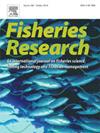时间法规对墨西哥湾休闲渔业渔获和丢弃的影响
IF 2.2
2区 农林科学
Q2 FISHERIES
引用次数: 0
摘要
旨在限制捕捞的渔业法规的变化可能对垂钓者的行为产生深远的影响——例如捕鱼的决定或保留或丢弃鱼的选择——并以复杂的方式影响已开发的鱼类种群。如果不了解这些相互作用,善意的法规可能会产生意想不到的后果。本研究使用统计模型分析了墨西哥湾珊瑚礁渔业暂时关闭对娱乐性捕捞和丢弃的影响,并特别关注了佛罗里达州西海岸的gag (Mycteroperca microlepis)。我们在一个综合框架内开发了两个模型:一个用于gag收获,另一个用于gag丢弃。收获和丢弃均受区域丰度、努力度、季节性和时间限制的影响。利用这些模型结合捕鱼努力量和呕吐物死亡率的估计,我们模拟了三种反事实情景下的收获、丢弃物和死亡丢弃物,这些情景由渔业管理人员考虑,具有不同的休闲季节开始日期(6月、9月和11月),以评估丢弃物和死亡丢弃物预测的变化,相对于全年呕吐季节关闭的基线。模拟表明,从6月、9月或11月开始的娱乐恶作剧季节将分别在平均27天、59天和27天内超过63.5万磅的年度捕获目标。相对于基线,六月份开始的休闲季节产生的死亡丢弃物数量最多,而九月或十一月开始的季节统计上导致的死亡丢弃物数量较少。我们得出结论,墨西哥湾gag娱乐季节开始日期影响总体gag死亡丢弃,并且最近决定将娱乐gag季节从6月转移到9月,既增加了季节持续时间,同时也可能降低墨西哥湾gag库存的捕捞压力。本文章由计算机程序翻译,如有差异,请以英文原文为准。
Influence of temporal regulations on harvest and discards in the recreational Gulf of Mexico gag (Mycteroperca microlepis) fishery
Changes in fishery regulations intended to constrain harvest can have profound effects on angler behavior – such as the decision to fish or the choice to retain or discard fish – and influence exploited fish stocks in complex ways. Without understanding these interactions, well-intended regulations may have unintended consequences. This study used statistical models to analyze the impact of temporal closures on recreational harvest and discards in the Gulf of Mexico reef fishery, and focused specifically on gag (Mycteroperca microlepis) along Florida’s west coast. We developed two models within an integrated framework: one for gag harvest and another for gag discards. Both harvest and discards were influenced by regional abundance, effort, seasonality, and temporal restrictions. Using these models in conjunction with estimates of fishing effort and gag discard mortality, we simulated harvest, discards, and dead discards under three counterfactual scenarios considered by fisheries managers with differing recreational season start dates (June, September, and November) to assess the changes in discard and dead discard projections relative to a baseline in which the gag season was closed all year. Simulations suggested that a recreational gag season starting in June, September, or November would exceed an annual catch target of 635,000 lbs gutted weight in 27, 59, and 27 days on average, respectively. A recreational season starting in June yielded the highest number of dead discards relative to the baseline, while seasons starting in September or November resulted in statistically fewer dead discards. We conclude that the Gulf of Mexico gag recreational season start date influences overall gag dead discards, and that a recent decision to shift the recreational gag season from June to September both increased the season duration while also likely lowering fishing pressure on the Gulf of Mexico gag stock.
求助全文
通过发布文献求助,成功后即可免费获取论文全文。
去求助
来源期刊

Fisheries Research
农林科学-渔业
CiteScore
4.50
自引率
16.70%
发文量
294
审稿时长
15 weeks
期刊介绍:
This journal provides an international forum for the publication of papers in the areas of fisheries science, fishing technology, fisheries management and relevant socio-economics. The scope covers fisheries in salt, brackish and freshwater systems, and all aspects of associated ecology, environmental aspects of fisheries, and economics. Both theoretical and practical papers are acceptable, including laboratory and field experimental studies relevant to fisheries. Papers on the conservation of exploitable living resources are welcome. Review and Viewpoint articles are also published. As the specified areas inevitably impinge on and interrelate with each other, the approach of the journal is multidisciplinary, and authors are encouraged to emphasise the relevance of their own work to that of other disciplines. The journal is intended for fisheries scientists, biological oceanographers, gear technologists, economists, managers, administrators, policy makers and legislators.
 求助内容:
求助内容: 应助结果提醒方式:
应助结果提醒方式:


